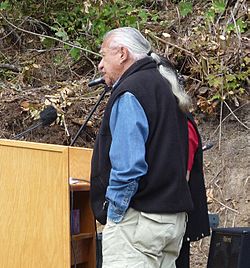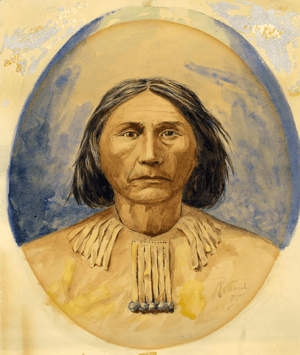Nisqually people facts for kids

Billy Frank Jr. (Nisqually), speaking at the Elwha Dam removal ceremony, photo by Doug Zimmer
|
|
| Regions with significant populations | |
|---|---|
| United States (Washington) | |
| Languages | |
| English, Nisqually | |
| Related ethnic groups | |
| other Coast Salish peoples |
The Nisqually are a Native American tribe. They live in western Washington state in the United States. They speak a language called Lushootseed. The Nisqually are part of the larger Coast Salish group of people. The U.S. government officially recognizes them as the Nisqually Indian Tribe.
Their home is the Nisqually Indian Reservation. It is located in the Nisqually River valley. The reservation covers about 20 square kilometers (7.9 square miles). It is on both sides of the river. In 2000, about 588 people lived there.
The tribe moved to their reservation in late 1854. This happened after they signed the Medicine Creek Treaty. Many tribal members, led by Chief Leschi, fought against this treaty. This conflict was called the Puget Sound War (1855–56). The Nisqually were eventually defeated by the US Army.
Contents
Nisqually Government and Leadership
The Nisqually Tribe has its own government. Their constitution and rules were approved in 1946. They were updated in 1994.
The main governing body is the General Council. This council includes all tribal members who are 18 years or older. A tribal council handles the daily business. This council has seven members. They are chosen by the tribe's voters.
Nisqually Language and Name
The Nisqually people speak a special kind of Lushootseed language. It is called Twalshootseed. This language belongs to the Salishan family.
The Nisqually call themselves Squalli-Absch or 'Susqually'absh (sq̓ʷaliʼabš). This means "people of the grass" or "People of the Grass Country" in their language.
Nisqually Homeland and Lifestyle
The Nisqually Indians originally lived in the forests and coastal areas. Their land stretched from Mount Rainier west to Puget Sound.
Like many other Northwest Coastal tribes, the Nisqually's life centered around fishing. Salmon was very important for their food and culture. In 1917, the government took about 14 square kilometers (3,370 acres) of their land. This land was used to create the Fort Lewis Military Reserve.
The U.S. government wanted this land for the fort. They offered the Nisqually people $25 per acre. The Nisqually did not have the money or power to fight this. After World War I ended in 1918, the Nisqually asked for their land back. They said the fort no longer needed it. But their request was not approved. For many years, they could hear cannons from the fort on their reservation.
Nisqually History
The Nisqually people have lived in their homeland for thousands of years. A legend says their ancestors came from the Great Basin. They crossed the Cascade Mountains. Their first village was near Skate Creek. Later, a big village was built near the Mashel River.
Fishing has always been central to the Nisqually. Salmon was their main food. It was also the basis of their culture. The Nisqually Tribe now helps manage the Nisqually River fisheries. They run two fish hatcheries.
The Nisqually Tribe lives on the Nisqually River. This is about 15 kilometers (9.3 miles) east of Olympia, Washington. In 2005, about 600 Native Americans lived on the reservation. Many others lived nearby. Since 1986, the tribe has bought back over 4 square kilometers (1,000 acres) of land.
The first reservation was set up by the Treaty of Medicine Creek in 1854. It was 5.2 square kilometers (1,280 acres) on Puget Sound. In 1856, it was made larger. It became 19.1 square kilometers (4,717 acres) on both sides of the Nisqually River.
In 1884, land was divided into family plots. These were on both sides of the Nisqually River. The river itself was not included. The people lived peacefully, fishing and growing potatoes. They also received some government food. In 1917, the U.S. Army took more of their land. They took 13.6 square kilometers (3,353 acres) to expand Fort Lewis.
Nisqually and European Settlers
In the 1840s, European settlers started moving into Nisqually lands. At first, the Nisqually people were peaceful with them. But things changed in 1853. The governor, Isaac Stevens, took away Native American land rights. He took millions of acres from different tribes.
Stevens tried to make a treaty with Chief Leschi of the Nisqually. This was the Treaty of Medicine Creek. Chief Leschi refused it. The treaty offered very little land. It also wanted the Nisqually to move away from Medicine Creek. They would have to move to a dry, isolated area. Many believe Governor Stevens' actions caused the Puget Sound War. He treated the Nisqually badly. He gave them land where it was hard to survive.
After the war, the Nisqually tribesmen got a new reservation. It was back along the river. But life was still hard. The reservation was small. Also, the U.S. military took 3,000 acres for Fort Lewis. Many Native Americans left the reservations. They looked for better homes and chances elsewhere. From the early 1900s to the 1940s, the U.S. government controlled Nisqually children's education. They tried to make them live like white Americans.
Nisqually Cuisine
Fish is a very important food for the Nisqually. They eat both fresh and smoked fish. Salmon is especially important. They also eat cod, eulachon, halibut, herring, sturgeon, and trout.
Traditionally, they hunted shellfish, deer, elk, and sea mammals. They also gathered wild plants. These included camas, wild berries, and crab apples.
Notable Nisqually People
- Billy Frank, Jr. (1931–2014), an important leader for the environment and treaty rights.
- Chief Leschi (1808–1858), a famous chief.
See also
In Spanish: Nisqually (tribu) para niños


